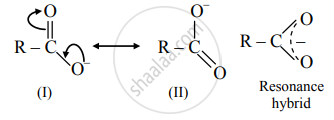Advertisements
Advertisements
प्रश्न
Explain the acidic nature of carboxylic acids.
उत्तर
Acidic nature of carboxylic acids:
- The carboxyl group (–COOH) imparts an acidic character to carboxylic acids.
- A carboxyl group is made of –OH group bonded to a carbonyl group.
- In aqueous solution, the H atom in OH of carboxyl group dissociates as proton and carboxylate ion is formed as the conjugate base,
\[\begin{array}{cc}
\phantom{.}\ce{O}\phantom{......................}\ce{O}\phantom{...........}\\
\phantom{.}||\phantom{......................}||\phantom{...........}\\
\ce{\underset{\text{Carboxylic acid}}{R - C -OH} + H2O ⇌ \underset{\text{Carboxylate ion}}{R - C - O-} + H3O+}
\end{array}\] - Carboxylate ion is resonance stabilized by two equivalent resonance structures as shown below.

- Carboxylate ion has two resonance structures (I) and (II) and both of them are equivalent to each other.
- This gives good resonance stabilization to carboxylate ion, which in turn gives an acidic character to carboxylic acids.
APPEARS IN
संबंधित प्रश्न
Correct order of acid strength for
- acetic acid
- fluoroacetic acid
- 4-Nitrobenzoic acid
- 4-Methyl benzoic acid is ______.
Write the reducing agent which CANNOT reduce –COOH group.
What is the action of following on proponal?
Hydroxyl amine
Write reactions for the following conversions.
4-Nitrobenzoic acid to Nitrobenzene
Write chemical reactions to convert –COOH group of acetic acid into the following.
CH4
Write chemical reactions to convert –COOH group of acetic acid into the following.
C2H5OH
Write chemical reactions to convert –COOH group of acetic acid into the following.
CH3COCl
Write reactions for the action of the following reagents on p-chlorobenzaldehyde.
Ethane-1,2-diol in presence of dry HCl.
Complete the following sequence of reactions and write structures for A, B, C.
\[\ce{Dry ice ->[i. Dry ether][ii. Hydrolysis] A ->[PCl5] B ->[H2(gas)][Pd - BaSO4] C}\]
Which of the following compounds reacts with ammonia to form urotropine?
Which is the gas evolved when carboxylic acids react with strongly electropositive metals (such as Na, K, Ca, Zn)?
Which of following elements does not form amide when reacted with ammonia?
Products in the following reaction are:
\[\ce{CH3COOH + PCl3 ->[\Delta]}\]
The elimination of CO2 from a carboxylic acid is known as ____________.
Which among the following is the strongest acid?
Which of the following functional groups is reduced by diborane?
Which of the following carboxylic acids ha highest acidic strength?
Write structure of adipic acid.
Which oxide of nitrogen is obtained on heating ammonium nitrate at 250°C?
Which of the following can reduce?
\[\ce{RCOOH -> RCH2OH}\]
How sodium bicarbonate test is used to distinguish between carboxylic acid and phenol?
How will you prepare Acetic anhydride from acetic acid?
